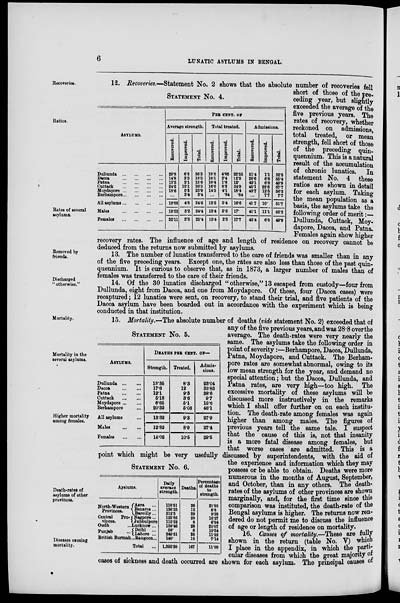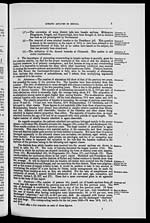Medicine - Mental health > 1867-1924 - Annual report of the insane asylums in Bengal > Insane asylums in Bengal annual reports 1867-1875 > Annual report on the insane asylums in Bengal for the year 1874
(796) Page 6
Download files
Individual page:
Thumbnail gallery: Grid view | List view

6 LUNATIC ASYLUMS IN BENGAL.
Recoveries.
Ratios.
Rates of several
asylums.
STATEMENT No. 4.
|
ASYLUMS. |
PER CENT. OF |
||||||||
|
Average strength. |
Total treated. |
Admissions. |
|||||||
|
Recovered. |
Improved. |
Total. |
Recovered. |
Improved. |
Total. |
Recovered. |
Improved. |
Total. |
|
|
Dullunda ... ... ... ... |
29.8 |
6.5 |
36.3 |
18.5 |
4.05 |
22.55 |
51.4 |
1.1 |
52.5 |
|
Dacca ... ... ... ... |
14.8 |
3.5 |
18.3 |
10.1 |
2.4 |
12.5 |
28.6 |
6.8 |
35.4 |
|
Patna ... ... ... ... |
13.5 |
2.1 |
15.6 |
10.4 |
1.6 |
12. |
43.1 |
6.8 |
49.9 |
|
Cuttack ... ... ... ... |
24.2 |
12.1 |
36.3 |
16.6 |
8.3 |
24.9 |
45.1 |
22.6 |
67.7 |
|
Moydapore ... ... ... ... |
18.6 |
5.3 |
23.9 |
14.3 |
4.1 |
18.4 |
43.7 |
12.5 |
56.2 |
|
Berhampore ... ... ... ... |
... |
3.4 |
3.4 |
... |
.84 |
.84 |
... |
7.7 |
7.7 |
|
All asylums ... ... ... ... |
19.88 |
4.8 |
24.6 |
13.2 |
3.4 |
16.6 |
41.7 |
10. |
51.7 |
|
Males ... ... ... ... |
19.23 |
5.2 |
24.4 |
13.4 |
3.6 |
17. |
41.1 |
11.1 |
52.2 |
|
Females ... ... ... ... |
22.11 |
3.3 |
25.4 |
15.4 |
2.3 |
17.7 |
43.4 |
6.5 |
49.9 |
12. Recoveries.—Statement No. 2 shows that the absolute number of recoveries fell
short of those of the pre-
ceding year, but slightly
exceeded the average of the
five previous years. The
rates of recovery, whether
reckoned on admissions,
total treated, or mean
strength, fell short of those
of the preceding quin-
quennium. This is a natural
result of the accumulation
of chronic lunatics. In
statement No. 4 these
ratios are shown in detail
for each asylum. Taking
the mean population as a
basis, the asylums take the
following order of merit:—
Dullunda, Cuttack, Moy-
dapore, Dacca, and Patna.
Females again show higher
recovery rates. The influence of age and length of residence on recovery cannot be
deduced from the returns now submitted by asylums.
Removed by
friends.
13. The number of lunatics transferred to the care of friends was smaller than in any
of the five preceding years. Except one, the rates are also less than those of the past quin-
quennium. It is curious to observe that, as in 1873, a larger number of males than of
females was transferred to the care of their friends.
Discharged
"otherwise."
14. Of the 30 lunatics discharged "otherwise," 13 escaped from custody—four from
Dullunda, eight from Dacca, and one from Moydapore. Of these, four (Dacca cases) were
recaptured; 12 lunatics were sent, on recovery, to stand their trial, and five patients of the
Dacca asylum have been boarded out in accordance with the experiment which is being
conducted in that institution.
Mortality.
Mortality in the
several asylums.
Higher mortality
among females.
STATEMENT No. 5.
|
ASYLUMS. |
DEATHS PER CENT. OF— |
||
|
Strength. |
Treated. |
Admis- |
|
|
Dullunda ... ... |
13.35 |
8.3 |
23.04 |
|
Dacca ... ... |
17.6 |
12 |
33.83 |
|
Patna ... ... |
12.1 |
9.3 |
38.6 |
|
Cuttack ... ... |
5.18 |
3.6 |
9.7 |
|
Moydapore ... ... |
6.65 |
5.1 |
15.6 |
|
Berhampore ... |
20.32 |
5.08 |
46.1 |
|
All asylums ... |
13.32 |
9.3 |
27.9 |
|
Males ... ... |
12.82 |
8.9 |
27.4 |
|
Females ... ... |
15.02 |
10.5 |
29.5 |
Death-rates of
asylums of other
provinces.
Diseases causing
mortality.
STATEMENT No. 6.
|
Ayslums. |
Daily |
Deaths. |
Percentage |
|
|
North-Western |
Agra ... |
118.51 |
26 |
21.93 |
|
Benares ... |
136.25 |
12 |
8.8 |
|
|
Bareilly ... |
312.5 |
29 |
9.28 |
|
|
Central Pro- |
Nagpore ... |
122.85 |
20 |
16.27 |
|
Jubbulpore |
115.22 |
8 |
6.94 |
|
|
Oudh ... |
Lucknow ... |
139.46 |
28 |
20.07 |
|
Punjab ... |
Delhi ... |
58. |
6 |
10.34 |
|
Lahore ... |
249.51 |
28 |
11.22 |
|
|
British Burmah ... |
Rangoon ... |
140. |
10 |
7.14 |
|
Total ... |
1,392.30 |
167 |
11.99 |
|
15. Mortality.—The absolute number of deaths (vide statement No. 2) exceeded that of
any of the five previous years, and was 28.8 over the
average. The death-rates were very nearly the
same. The asylums take the following order in
point of severity:—Berhampore, Dacca, Dullunda,
Patna, Moydapore, and Cuttack. The Berham-
pore rates are somewhat abnormal, owing to its
low mean strength for the year, and demand no
special attention; but the Dacca, Dullunda, and
Patna rates, are very high—too high. The
excessive mortality of these asylums will be
discussed more instructively in the remarks
which I shall offer further on on each institu-
tion. The death-rate among females was again
higher than among males. The figures of
previous years tell the same tale. I suspect
that the cause of this is, not that insanity
is a more fatal disease among females, but
that worse cases are admitted. This is a
point which might be very usefully discussed by superintendents, with the aid of
the experience and information which they may
possess or be able to obtain. Deaths were more
numerous in the months of August, September,
and October, than in any others. The death-
rates of the asylums of other provinces are shown
marginally, and, for the first time since this
comparison was instituted, the death-rate of the
Bengal asylums is higher. The returns now ren-
dered do not permit me to discuss the influence
of age or length of residence on mortality.
16. Causes of mortality.—These are fully
shown in the return (table No. V) which
I place in the appendix, in which the parti-
cular diseases from which the great majority of
cases of sickness and death occurred are shown for each asylum. The principal causes of
Set display mode to: Large image | Zoom image | Transcription
Images and transcriptions on this page, including medium image downloads, may be used under the Creative Commons Attribution 4.0 International Licence unless otherwise stated. ![]()
| Permanent URL | https://digital.nls.uk/83380388 |
|---|




